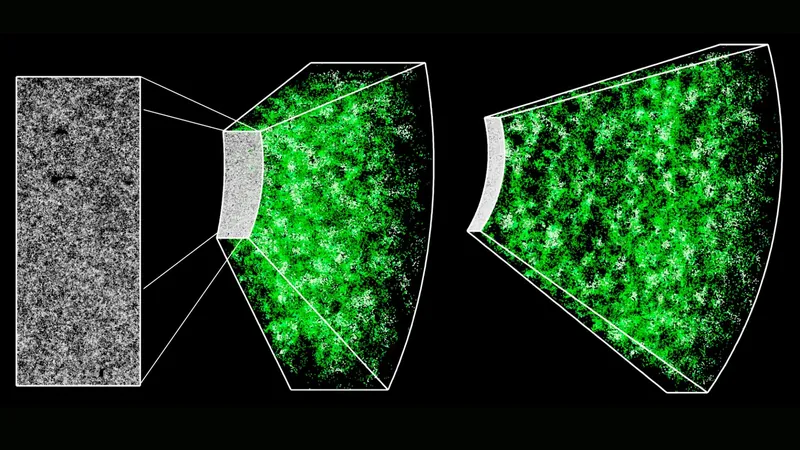
Scientists Uncover Potential New Physics Behind Cosmic Structure Suppression!
2025-01-03
Author: Kai
In a groundbreaking study published in *Physical Review Letters*, a team of researchers has examined the most extensive set of galaxy clustering data to date, revealing a perplexing suppression in the growth of cosmic structures. This finding presents a significant challenge to the widely accepted Lambda Cold Dark Matter (ΛCDM) model of cosmology and hints at the possibility of new physics at play.
The ΛCDM model has been the standard framework for understanding the universe's evolution, encompassing components such as cold dark matter, normal matter, radiation, and dark energy represented by the cosmological constant (Λ). This model successfully explains various cosmological phenomena, including the universe's large-scale structure and the cosmic microwave background (CMB) radiation, seen as an echo of the Big Bang.
However, as researchers probe deeper into cosmic anomalies, it becomes clear that the ΛCDM model falls short in addressing phenomena such as cosmic inflation and the controversial roles of dark energy and dark matter. Recent observations, particularly from the Dark Energy Survey Instrument (DESI), have exposed potential inconsistencies that could reshape our understanding of the universe.
A distinguished research team, including Dr. Shi-Fan Chen from the Institute for Advanced Study, Professor Mikhail Ivanov from MIT, Dr. Oliver Philcox from Columbia University, and graduate student Lukas Wenzl from Cornell, set out to investigate whether these anomalies are interconnected and indicative of a new physical model.
Dr. Chen shared, "The thrill of predicting behavior in the cosmos is incredible. What adds to this excitement is synthesizing diverse measurements into one unified effective theory."
Connecting the Cosmic Dots
Recent measurements have highlighted significant disagreements, notably the Hubble tension—the discrepancies between direct and indirect measurements of the universe's expansion rate—and the matter clustering debate known as the σ8 tension. The new research approached these issues by amalgamating various datasets, including the BOSS (Baryon Oscillation Spectroscopic Survey) DR12 and low-redshift galaxy samples, while cross-correlating with CMB gravitational lensing data.
The researchers maintained a rigorous standard in their data selections, discarding erroneous measurements to ensure consistency. "We aimed for high accuracy in our definitions of galaxy samples, even if it meant less statistical power," Dr. Philcox explained.
A Universe Growing Too Slowly?
Their analysis of the ΛCDM model revealed a significantly lower rate of structure growth than predicted, with a notable 4.5σ tension against Planck's observations. The dynamical dark energy scenario yielded no substantial evidence for alternate models, suggesting that dark energy may behave consistently with the cosmological constant.
Professor Ivanov noted, "Our results indicate that the formation of structures in the late universe is markedly suppressed compared to early universe predictions, even when allowing deviations from conventional dark energy models."
New Physics or Data Errors?
The research team calculated that the probability of this suppression being a random occurrence stands at an alarming 1 in 300,000, strongly indicating the presence of either unknown systematic errors in the data or hints of groundbreaking new physics. The findings hold significant implications for understanding the σ8 tension and demonstrate that dynamical dark energy cannot alone account for the discrepancies.
Wenzl remarked, "If this signal is confirmed, it opens the door to exploring new physics, such as non-standard dark matter candidates that could alter structure formation."
This compelling study threatens to upend long-standing cosmological theories and may signal a necessary reevaluation of our grasp on the universe's grand structure. As upcoming galaxy surveys prepare to offer deeper insights, the quest for answers may reveal a more complex universe than we ever anticipated.
Stay tuned for scientific developments that could redefine our perspective on cosmic evolution!

 Brasil (PT)
Brasil (PT)
 Canada (EN)
Canada (EN)
 Chile (ES)
Chile (ES)
 Česko (CS)
Česko (CS)
 대한민국 (KO)
대한민국 (KO)
 España (ES)
España (ES)
 France (FR)
France (FR)
 Hong Kong (EN)
Hong Kong (EN)
 Italia (IT)
Italia (IT)
 日本 (JA)
日本 (JA)
 Magyarország (HU)
Magyarország (HU)
 Norge (NO)
Norge (NO)
 Polska (PL)
Polska (PL)
 Schweiz (DE)
Schweiz (DE)
 Singapore (EN)
Singapore (EN)
 Sverige (SV)
Sverige (SV)
 Suomi (FI)
Suomi (FI)
 Türkiye (TR)
Türkiye (TR)
 الإمارات العربية المتحدة (AR)
الإمارات العربية المتحدة (AR)